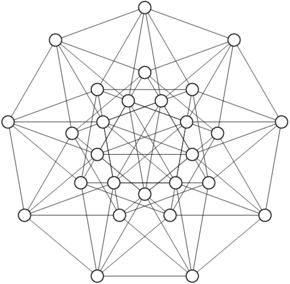Hamming graph
| Hamming graph | |
|---|---|
| Named after | Richard Hamming |
| Vertices | |
| Edges | |
| Diameter | |
| Spectrum | |
| Properties |
-regular Vertex-transitive Distance-regular[1] |
| Notation | |
Hamming graphs are a special class of graphs named after Richard Hamming and used in several branches of mathematics and computer science. Let S be a set of q elements and d a positive integer. The Hamming graph H(d,q) has vertex set Sd, the set of ordered d-tuples of elements of S, or sequences of length d from S. Two vertices are adjacent if they differ in precisely one coordinate; that is, if their Hamming distance is one. The Hamming graph H(d,q) is, equivalently, the Cartesian product of d complete graphs Kq.[1]
In some cases, Hamming graphs may be considered more generally as the Cartesian products of complete graphs that may be of varying sizes.[2] Unlike the Hamming graphs H(d,q), the graphs in this more general class are not necessarily distance-regular, but they continue to be regular and vertex-transitive.
Special Cases
- H(2,3), which is the generalized quadrangle G Q (2,1)[3]
- H(1,q), which is the complete graph Kq[4]
- H(2,q), which is the lattice graph Lq,q and also the rook's graph[5]
- H(d,1), which is the singleton graph K1
- H(d,2), which is the hypercube graph Qd[1]
- H(3,3), which is a unit-distance graph with n=27 vertices and n4/3=81 edges (below)
Applications
The Hamming graphs are interesting in connection with error-correcting codes[6] and association schemes,[7] to name two areas. They have also been considered as a communications network topology in distributed computing.[4]
Computational complexity
It is possible to test whether a graph is a Hamming graph, and in the case that it is find a labeling of it with tuples that realizes it as a Hamming graph, in linear time.[2]
References
- 1 2 3 Brouwer, Andries E.; Haemers, Willem H. (2012), Spectra of graphs, Universitext, New York: Springer, p. 178, ISBN 978-1-4614-1938-9, MR 2882891, doi:10.1007/978-1-4614-1939-6.
- 1 2 Imrich, Wilfried; Klavžar, Sandi (2000), "Hamming graphs", Product graphs, Wiley-Interscience Series in Discrete Mathematics and Optimization, Wiley-Interscience, New York, pp. 104–106, ISBN 0-471-37039-8, MR 1788124.
- ↑ Blokhuis, Aart; Brouwer, Andries E.; Haemers, Willem H. (2007), "On 3-chromatic distance-regular graphs", Designs, Codes and Cryptography, 44 (1-3): 293–305, MR 2336413, doi:10.1007/s10623-007-9100-7. See in particular note (e) on p. 300.
- 1 2 Dekker, Anthony H.; Colbert, Bernard D. (2004), "Network robustness and graph topology", Proceedings of the 27th Australasian conference on Computer science - Volume 26, ACSC '04, Darlinghurst, Australia, Australia: Australian Computer Society, Inc., pp. 359–368.
- ↑ Bailey, Robert F.; Cameron, Peter J. (2011), "Base size, metric dimension and other invariants of groups and graphs", Bulletin of the London Mathematical Society, 43 (2): 209–242, MR 2781204, doi:10.1112/blms/bdq096.
- ↑ Sloane, N. J. A. (1989), "Unsolved problems in graph theory arising from the study of codes" (PDF), Graph Theory Notes of New York, 18: 11–20.
- ↑ Koolen, Jacobus H.; Lee, Woo Sun; Martin, William J. (2010), "Characterizing completely regular codes from an algebraic viewpoint", Combinatorics and graphs, Contemp. Math., 531, Providence, RI: Amer. Math. Soc., pp. 223–242, MR 2757802, doi:10.1090/conm/531/10470. On p. 224, the authors write that "a careful study of completely regular codes in Hamming graphs is central to the study of association schemes".
External links
- Weisstein, Eric Wolfgang. "Hamming Graph". MathWorld.
